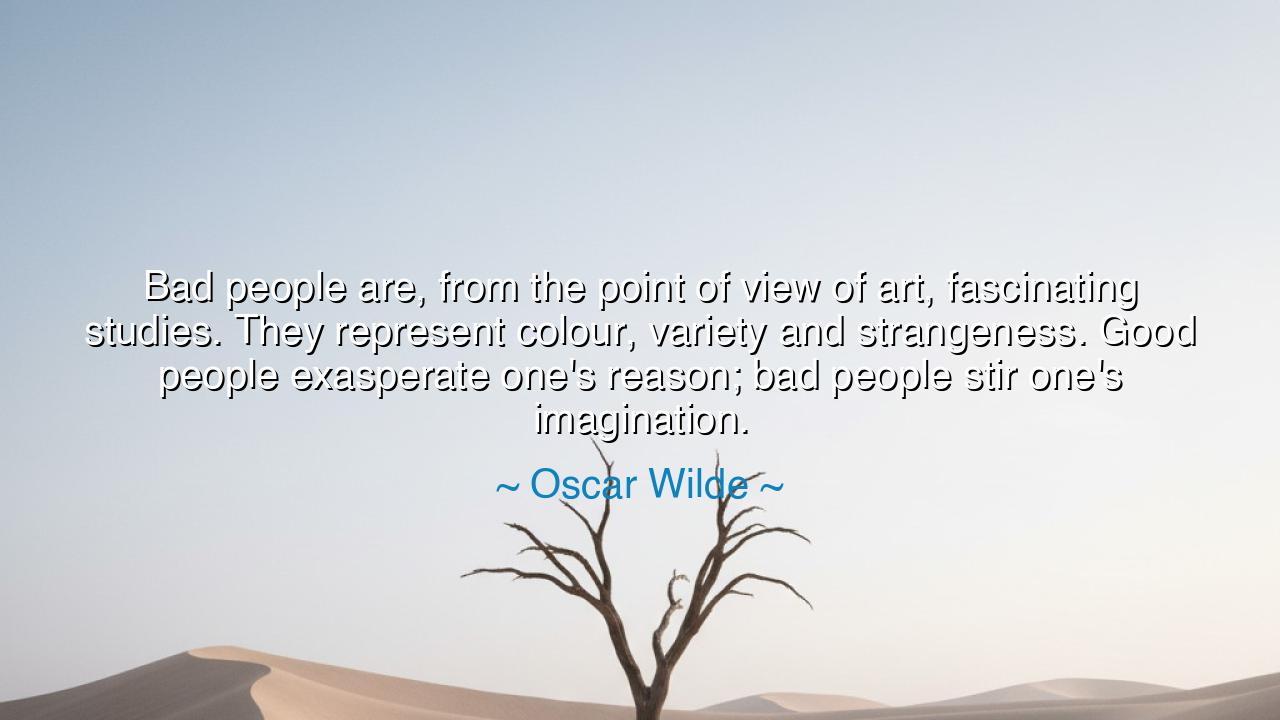
Bad people are, from the point of view of art, fascinating
Bad people are, from the point of view of art, fascinating studies. They represent colour, variety and strangeness. Good people exasperate one's reason; bad people stir one's imagination.






“Bad people are, from the point of view of art, fascinating studies. They represent colour, variety and strangeness. Good people exasperate one’s reason; bad people stir one’s imagination.” Thus spoke Oscar Wilde, the eternal aesthete, the lover of paradox, and the master of beauty and irony. In this statement, Wilde reveals a truth both troubling and profound: that within the realm of art, it is not virtue that excites the soul, but vice; not simplicity that awakens wonder, but complexity; not the calm of the righteous, but the storms of the wicked. He does not praise evil for its own sake, but recognizes that from the imagination’s perspective, conflict, contradiction, and fallibility are the lifeblood of art. The “bad” person is not admirable—but he is fascinating, for in his depths we glimpse the drama of being human.
The origin of this quote lies in Wilde’s lifelong meditation on the tension between morality and art, a theme that runs like gold through his essays and plays. In his famous work The Picture of Dorian Gray, Wilde embodied this very idea: the perfect, beautiful Dorian, who seems good to the world, hides within him corruption and sin—and it is that very corruption that gives his story its power. Wilde, who once declared that “there is no such thing as a moral or an immoral book,” believed that art transcends the narrow boundaries of virtue. It is not concerned with judging human nature, but with revealing it in all its shades. Where moral philosophy seeks purity, art seeks truth—and truth, as Wilde knew, is seldom pure and never simple.
To the artist, the “bad” person is rich with contradiction. He embodies desire and despair, brilliance and decay, cruelty and charm. Such a figure moves the imagination because he mirrors the secret shadows within us all—the impulses we suppress, the hungers we deny, the chaos beneath our masks. The good person, on the other hand, often seems static, resolved, unchanging. His virtue may command respect, but it leaves the artist’s pen unmoved. In the world of storytelling, the villain often glows brighter than the hero—not because evil is better, but because it is more human, more dynamic, more alive. Wilde’s insight is not cynicism; it is the recognition that art, in order to breathe, must draw from both light and darkness.
Consider, for example, the legend of Faust, who sells his soul to the devil for knowledge and pleasure. The tale has endured for centuries, retold by Marlowe, Goethe, and countless others, not because of its morality, but because of its imagination—its bold confrontation with temptation and consequence. Faust, the “bad” man, becomes immortal in art precisely because his inner struggle reflects humanity’s eternal hunger for more—more understanding, more beauty, more power, even at the cost of salvation. The artist finds in Faust not a sinner to condemn, but a mirror to behold—the restless, imperfect creature who dares to reach beyond his limits.
Wilde himself lived as one of these “fascinating studies.” He was adored and despised, celebrated and condemned, a man of dazzling wit and tragic flaw. His brilliance stirred imagination; his downfall stirred pity. To those who sought moral perfection, he was scandalous; to those who sought art, he was glorious. Through his life and his words, Wilde demonstrated that the artist must love humanity not for its virtue, but for its complexity. Good people may guide society—but bad people, with all their contradictions, feed the artist’s flame. In their chaos, he finds his color, his music, his story.
Yet there is a deeper wisdom beneath Wilde’s paradox. He does not urge us to become “bad,” but to see deeply—to look beyond moral labels and perceive the richness of the soul. For within every human being lies a spectrum of light and shadow. The wise artist, and indeed the wise person, learns not to judge too quickly, but to understand. Those we call “bad” are often those who have dared too much, desired too deeply, or fallen too far. Their lives, like storms, reveal the hidden architecture of the world—the strength of its winds, the power of its tides. To study them is not to glorify wickedness, but to know what it means to be alive.
O seeker of truth, remember this: imagination thrives not in perfection, but in paradox. Do not turn away from what is strange, dark, or uncomfortable. In those places lies the pulse of creation. Learn to see the beauty even in brokenness, for it is through contrast that art gains its color, and through tension that life gains its depth. Let your reason honor goodness, but let your imagination be free to wander the full field of human experience. For as Wilde teaches, it is the imperfection of man that makes him magnificent—and it is in the study of both his virtues and his vices that we come to understand not only art, but the mystery of the soul itself.






AAdministratorAdministrator
Welcome, honored guests. Please leave a comment, we will respond soon